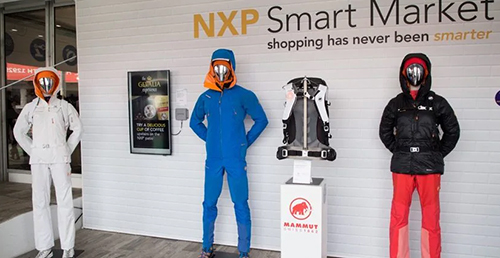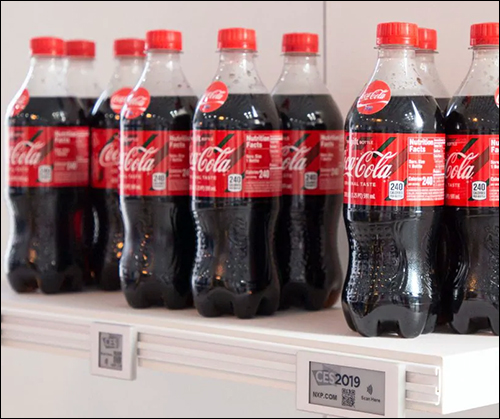Several brands and retailers, as well as technology solution providers, joined forces with NXP Semiconductors in demonstrating what the technology company calls a “smart market,” at this year’s Consumer Electronics Show (CES), held this month in Las Vegas. The simulated market leveraged NXP’s Near Field Communication (NFC)- and RFID-based products to demonstrate how technology can make product inventory more accurate, and shopping more interesting and efficient for consumers. The smart market showed how store access and payments can be accomplished via wearables or smartphones, and also demonstrated electronic shelf labels and intelligent refrigerators that can serve as vending machines.
The smart market featured NFC-enabled coffee makers from Kraft Heinz’s Gevalia Coffee, as well as Coca-Cola Co.‘s smart vending machines and Mammut‘s RFID-enabled clothing and gear. Retailers Stora Enso and Decathlon also participated, along with technology companies Kathrein Solutions, Ingenico, Opticon and TPG Rewards.

During the exhibition, CES attendees were provided with NXP wristbands that had built-in MIFARE NFC chips and UHF RFID UCODE chips, so that they could interact with the demos as though they were store shoppers. Additionally, Gevalia demonstrated how NFC tag reads can enable consumers to engage with the brand and win free coffee.
Mammut, a Swiss outdoor adventure company, is incorporating NFC directly into its clothing and gear products. Consumers can read tags via a mobile phone in order to access an app. They can then begin planning their adventure based on tag reads.
Coca-Cola demonstrated its RFID-enabled refrigerator that is being used at some gas stations. When drivers pay for gasoline at the pump, the payment terminal built into the pump displays an invitation to “refresh and refuel,” which they can do by purchasing a container of Coke at an adjacent refrigerator. The system then charges the driver as he or she removes the beverage from the vending machine; as the tagged product is removed from the cooler, its tag is no longer read and software identifies its removal.

The smart market displayed electronic shelf labels from Opticon, as well as a virtual fridge from Stora Enso that (like the Coca-Cola demo) charges a user as he or she removes products from the shelf. Additionally, the system utilizes UHF RFID-enabled automated-payment solutions in the form of self-checkout systems from Decathlon and smart point-of-sale (POS) terminals from Igenco, using NFC technology.
Finally, a personalization feature utilized the wristband’s UHF RFID technology to engage with attendees as they approached a digital display. A reader at the display interrogated the tag within a few feet, identified the individual and greeted him or her by name. “We call it the retail of the future,” says Markus Staeblein, NXP’s VP and general manager of secure mobility and retail. “Shopping has never been smarter.”
The featured demos fell into three application categories: smart supply, in-store experience, and consumer interaction or brand connection. The smart market was intended to prove how technology can make brick-and-mortar stores highly interactive, personalized, secure and efficient.
“When you see the big mega-trends taking place in retail,” Staeblein says, technology offers some key solutions. For instance, he explains, inventory accuracy gained with UHF RFID technology can reduce the need for over-stocking, as well as lower the incidence of lost sales due to out-of-stocks. “This is something we’re already doing with RFID, and we’ll continue doing that and expanding that.”
The next big step, according to Staeblein, is to improve the consumer experience within the store. Retailers have shifted their focus from growing larger to enhancing the experience they offer shoppers onsite. “They are looking at providing more excitement in the store,” he states, “and making consumers more connected to the products.”
Another mega-trend Staeblein points to is the combatting of counterfeit products. According to a 2018 Research and Markets report, retailers and brands globally lost $1.2 trillion due to counterfeiting in 2017. NFC labels affixed to products can help to combat those counterfeits by enabling consumers and businesses to tap their phones against labels to confirm product authenticity.
NFC also enables mobile payments at stores, says Mike Klein, NXP’s marketing communications manager. Shoppers can use NFC on their mobile phones, or stores can utilize loyalty cards, facial recognition and artificial intelligence. Consumers are already accustomed to self-checkout systems at stores, by which they must scan the bar codes on the products they purchase. With NFC or RFID, that process can be made faster and more automatic, with readers built into POS counters or at exits, in order to automatically identify what is being purchased and then bill customers accordingly.
Another key solution on which NXP and other solution providers are focusing is dynamic pricing, Staeblein reports, in the form of electronic shelf labels with NFC technology. In this way, prices can be updated remotely, even according to the time of day at which shopping takes place. What’s more, shelf labels can serve as an alternative to item-level tags, enabling consumers to access data.
Consumers can utilize electronic shelf labels to capture information regarding products that are not already tagged, by tapping their phones against NFC tags built into the labels. In this way, they could check pricing, view information from consumers about particular products or read specifications.
Smart vending machines, such as the one Coca-Cola now offers at gas stations, enable customers to provide a credit card for payment to a machine, then open the refrigerator door, take what they want and automatically be billed for that item, based on the RFID tag read.
The third application is consumer interaction, Staeblein states. Consumers can use their own phones to read NFC tags, view information about a product, collect loyalty points or participate in contests. “When you look at the breadth of our portfolio,” Klein says, “what we’re bringing to life is an end-to-end shopping experience.”
All of the demos at the smart market display represented systems on trial or deployed by brands and retailers. The smart shelves were provided by Surge Cloud, while the interactive advertising and POS solutions demonstrated were provided by Ingenico or TPG.



